Interstate 94 leading into Detroit is bordered by tall walls adorned with decorative tiles patterned with stylized motifs of windswept leaves. The design is quaint, but its charm marred by peeling paint on the blue arcs representing the wind. It seems rather odd that it should be deteriorating already, for the walls appear fairly new, probably installed within the last couple of years. Entering the metropolis, these foliated walls continue, belying the surrounding city until the tops of high-rises eventually peer over the fortified highway corridor, betraying its factitiousness. One soon realizes that something might be wrong when it becomes apparent: most of these edifices are vacant, even gutted. The stark contrast between decorative foliage and urban decay becomes very disconcerting. It would be easy to stay on the relatively safe path of the highway and just pass through this place. However, Detroit was my destination.
I have traveled extensively throughout North and South America; and having seen countless cities in varying states of dilapidation, I thought I had a good idea of what to expect in Detroit. I was wrong.
Exiting the interstate was like entering another country. The sheer magnitude of decay and devastation in Detroit is overwhelming. The number of derelict buildings literally falling apart, the piles of rubble and litter all over the streets and sidewalks, the fact that there was so little police presence in some areas, or so little human presence at all, was eerily unsettling.
![2014-04-04-DSCN722550Percent.jpg]()
View down a deserted Detroit street.
Isolated populations inhabit ghost neighborhoods of deserted buildings. In some vicinities, all of the structures on entire blocks have been demolished, leaving only empty fields of weeds, grass and debris.
![2014-04-04-DSCN754550percent.jpg]()
A street surrounded by fields, the former sites of buildings that were demolished.
In other areas, many houses still remain, but nearly all of them are in various states of decomposition, from boarded up to burned out, possibly casualties of "Devil's Night," the night before Halloween, when people burn abandoned houses for fun.
![2014-04-04-IMG_483350percent.jpg]()
One of the many burned-out houses in Detroit.
![2014-04-04-IMG_4752.JPG]()
Site of a recently razed house.
Venerable, large, many of these crumbling structures would probably have been cherished as historical homes were they not situated on land that has negative value. Driving between several blocks of row houses, one might see only five or six people. Commercial and industrial zones are even sparser. Crime and civic breakdown are so bad that businesses won't move in.
![2014-04-04-IMG_475550Percent.jpg]()
A collapsing house, apparently recently occupied.
Disquiet and amazement at the scene were swirling around in my mind when I was astounded by another phenomenon. Paintings were everywhere. To be on one of these deserted streets was to be surrounded by a singular mélange of sign paintings, graffiti, mosaics and unusual advertising posters and installations. I didn't go to Detroit to see art. I went there to see the city. Little did I know that even though I wouldn't even make it to see the famous murals by Diego Rivera, I would see more paintings in two days driving through Detroit than I could possibly see in the same amount of time at galleries in Los Angeles. It is amazing that public art flourishes in a city known for trying to sell off its art museum. Perhaps it doesn't need one. The broken down brick and mortar of the city itself has become a huge outré art gallery.
![2014-04-04-IMG_523150percent.jpg]()
An interesting sign painting on the side of a hair salon. The floral border is done in a graffiti-esque style, as are many other signs in Detroit; many business owners are not totally opposed to graffiti.
Detroit apparently has a long tradition of commercial painting. In contrast to the prefabricated signs that seem to be the norm in most cities, nearly all of the commercial buildings I saw in Detroit were hand-painted with not only text, but also pictures illustrating the services or goods offered inside. Many of these murals were painted in highly original styles, without a trace of predictability or mass-production as one might expect. Sensitively painted images of sundries such as pizzas, fruit, or tires remain on vacant buildings, testaments to a previous occupant. Sometimes, multiple layers of paintings serve as monuments to several generations, as, whether out of respect or neglect, new businesses never removed all traces of predecessors. Now these old paintings serve as foundations for new graffiti, which in many cases, augments and draws attention to them more than it obliterates them.
![2014-04-04-IMG_508950percent.jpg]()
A building collaged with signage and graffiti.
Strangely, though most vacant commercial buildings are covered in profusions of colorful graffiti, hardly any open businesses have been touched by it. Likewise, very little graffiti has been covered over by other tags. Looking at block after block of tagged buildings, it becomes evident that a fairly strict etiquette is in place, followed assiduously by most graffitists.
And why should there not be one? The abundance of unused buildings leaves plenty of room for everyone who wants to leave a mark. There is little reason to cover over others' work or deface businesses trying to stay afloat, except to make a negative commentary on them. This is graffiti artist paradise: Most of the city is a blank canvas.
In fact, metropolitan Detroit has recently become something of a mecca for street artists, as graffitists from around the world have been flying in to take advantage of the abundant opportunities. Some have even moved to Detroit, including "Revok," formerly from Los Angeles.
The city's international fame among graffitists might be partially due to "The Detroit Beautification Project," a joint effort started last year by a team of street artists including Revok, local galleries, and a spray paint company, who have succeeded in securing approval from building owners and city officials to paint murals in Hamtramck, a small city enclosed by Detroit.
Yet in spite of their abundant opportunities, street artists in metro Detroit face a great deal of opposition. A May 2012 post on Detroit's Metro Times blog reported that residents of Hamtramck circulated petitions calling for the removal of some of the murals; but a counter-petition in favor of them garnered over twice as many signatures. The possibility of mural removal was discussed, but ultimately dismissed, at city council meetings.
I saw a number of the Hamtramck murals. Technically admirable and conceptually prepense, they were more sophisticated than typical graffiti. Still, I was more drawn to the total inundation of graffiti and signage in Detroit itself. Detroit's polyglot accumulations of paintings seemed more vital, more representative of the world around them than Hamtramck's individual artworks. In Hamtramck, each mural seems detached, not quite connected to its surroundings. Possibly, this is because they were more planned and labored, less spontaneous. More probably, it is because they are isolated -- each one exists as a solitary unit, with little or no other painting beside it, in contrast to Detroit's unplanned cacophony of work by different artists from different time periods for different purposes. Bold, colorful painting has taken over Detroit, almost in defiance of the city's breakdown.
Some of the pieces are name tags in styles ranging from hastily scrawled to intricately detailed; some are clever epigrams; others are more overt expressions of affection or antipathy towards certain individuals. The tone of these statements ranges from comic to somber; many memorialize the dead. I even saw a few inscriptions urging people to vote for certain candidates for political offices. (I later heard that one of these candidates had painted over some such graffiti himself, fearing that it would do more harm than good to his campaign.)
Cottage industries have developed around creating custom advertisements, evinced by signs to that effect along with Photoshopped examples of their handiwork pasted amongst the graffiti. Not all of the graffiti was text; much of it was images. Enterprising taggers had even covered entire sides of high-rise buildings in abstract splotches of color.
![2014-04-04-IMG_540550percent.jpg]()
A waterfall of spray paint.
Wandering around the city, I became more and more intrigued by my painted surroundings. I wondered why I'd never paid much attention to graffiti before. Due to its general illegal or undesirable status, it typically exists in the margins of society. In affluent neighborhoods, a graffito seems reactionary, an obtrusive tattoo on genteel surroundings; in other locales, it could serve as a territorial signal or billboard the identity of the artist, or simply convey some idea or image. Either way, conspicuous graffiti is usually covered over unless it is in an out-of-the way or hard to reach location. Instead of existing in the margins, in the wastelands of Detroit, graffiti is to the fore.
![2014-04-04-IMG_513950percent.jpg]()
New signage, but the roof on this building is gone.
Empty walls become forums for communication, public diaries. It feels as though the city is literally writing its own history on itself. The experience of traversing one of these areas is poignant and completely engrossing.
![2014-04-04-IMG_529050percent.jpg]()
Mural on the side of a building in Mexicantown, a Detroit neighborhood.
The more graffiti I saw, the less I noticed all the detritus. I became so absorbed in looking at the paintings that I almost forgot where I was. It's hard not to become depressed when surrounded by such squalor, but the graffiti, combined with the interesting commercial paintings, provides a more interesting and cheerful center of attention. Few people think illicit graffiti should be legal, for few would want their own property altered or defaced without their permission. Therefore, graffiti is generally considered a "bad," in economic terms; and the more noticeable, the worse. However, in the unique case of Detroit, graffiti, more prominent than ever, seems to swing more toward the status of being a "good." Here the graffiti has value because it provides a stimulating contrast to the lugubrious urban landscape.
![2014-04-04-IMG_513650percent.jpg]()
Is this whimsical drawing graffiti or is it an authorized mural?
Not everyone in Detroit feels that way, of course. In fact, some residents are so opposed to graffiti that they have begun acting as de facto anti-graffiti squads, physically assaulting street artists and damaging their cars, knowing that graffitists won't notify the authorities because their actions are illegal as well. Vigilantes attacked more than 12 artists in the month of June, according to a June 28 article in the Motor City Muckraker webzine. Local disgruntlement is certainly understandable, given the fact that outsiders and even foreigners are coming in to Detroit to leave their mark. Considering graffiti's stigma and its territorial connotations, it's not unreasonable for locals to feel that these graffitists are marking territory that isn't theirs in an effort to take over. It also is hard to dispute that the graffitists, especially the outsiders, are taking advantage of a bad situation. They don't have to live in it. It's easy for them to sail through the murky backwaters in relative peace, unanchored by poverty or deep ties to the area; just as it was easy for me to pass through the city, enjoy its art, and now comment on it.
The graffiti might have value, but to whom? A Detroit art gallery achieved some local notoriety when they removed a mural, wall and all, by the famous professional artist Banksy, from a building without permission from the building owner. In Hamtramck, locals whitewashed an unapproved billboard by professional collective "TrustoCorp", but the collective had it removed and secured, presumably for reuse and eventual sale. According to the May 2012 Metro Times blog post, if it were restored, the billboard would fetch between $10,000 and $20,000.
I'd never had much interest in the genre of professional "street art," as seen in galleries, because its paradoxicality seems to overstretch its credibility. There are many exceptions, but often, its concepts seemed to me to be specious, its motifs derivative, and its relational aesthetics too facilely predicated on spurious disobedience to authority. Perhaps I felt that if this sort of urbane graffiti represented the pinnacle of street art quality, I wasn't interested; or maybe I just hadn't looked at enough graffiti to understand the complexity of its dynamics. At any rate, seeing the art in Detroit opened my mind toward a greater appreciation of graffiti of all kinds.
![2014-04-04-IMG_712650percent.jpg]()
A mural in Corktown, Detroit's oldest neighborhood. Notice the rusted traffic light in the foreground.
The Michigan Department of Transportation (MDOT) website bears a brief essay titled, "Graffiti: Artistic Expression or Vandalism?" It is amazing that people are so shallow as to reduce such a complex and multifaceted issue to a simplistic either-or. To ask such a question is to equivocate a political issue with an artistic one. Art and vandalism are not mutually exclusive. If an artist paints on a canvas that isn't his, is his painting therefore not art? Unauthorized graffiti can be both art and vandalism. Artists who decide to go outside boundaries, whether legal, social or traditional, do so knowing that they might face consequences. For them, the risk is worthwhile. Even some proponents of the genre make a distinction between graffiti and "street art": in their definition, graffiti is illegal, whereas street art is legal. Ironic, considering that the definition of the word "graffiti" doesn't predicate illegality, but street art is often shown inside galleries.
The article on the MDOT website urges anyone who witnesses a graffitist at work on bridges or overpasses to alert authorities. The Michigan government doesn't want the city's problems spilling over onto state-owned highways, so it spent more than $500,000 in 2012 on graffiti removal in the Detroit metro area. Personally, I found the graffiti more interesting and appropriate to the area than the manufactured charm of the ornamental walls.
When people pit graffiti's artistic and legal characteristics against one another, what they seem to want to discuss is: is graffiti good or bad? Could its benefits possibly outweigh its detriments? Does its transgressive nature nullify its artistic value, or vice versa?
Clearly, the issue is more symbolic than functional. In the case of Detroit, the debate becomes purely theoretical, since the authorities don't do much about it anyway, nor should they. Funds are too short. The money is needed elsewhere for major services, and the city recently declared bankruptcy. Traditionally, graffiti is illegal because it undermines property owners' control over their belongings. The owners of most of Detroit's prolifically decorated buildings have long since relinquished control over them. Whether or not the graffiti looks worse than a disintegrated building is an aesthetic issue, not a true problem. Surely the graffiti is not bringing down the property values in most of these areas of Detroit, for the property value is, in many cases, already negative. The graffiti simply isn't doing any harm. Crimes much worse than illegal graffiti are being committed every day throughout the Detroit metro area; some areas are so dangerous that the police won't even enter them. In an effort to shoulder some of the responsibilities abdicated by police, residents of some areas post signs to telephone poles warning visitors that roaming thieves may steal gold jewelry right off their bodies.
The altered social and political dynamics in Detroit have transformed the graffiti dynamics. Rather than an intrusion on a civilized veneer, in Detroit, graffiti is there at every turn, on practically every street corner, reminding passers-by that no one in this city is really in control. Detroit's no-man's-land is, paradoxically, a free-for-all. Instead of sabotaging the look and principles that the city purports to stand for, these artists are working with them. They are finding freedom of expression amid political and social upheaval, creative oases in a rotten world. These artists aren't subverting the property owners, per se, but rather exploiting the oppressive environment that is their canvas, the decayed political and social structures it represents. Graffiti is a symptom of Detroit's problems, hardly a part of them. The more graffiti there is, the more political and social breakdown is symbolized. This is precisely why, in a broken, bankrupt city rampant with theft, violent crime and jailed politicians, graffiti is still such a hotly contested issue. The artists' willful acts lay bare the ineffectuality of the city's governmental infrastructure, and many do not want to admit it. They are so invested in the city that the gritty magnetism of its painted surfaces fails to appeal to them.
One empathizes with those who live in and love Detroit. It is truly regrettable that what was once one of our country's greatest, most vibrant cities has become so desolate and distressed. In this urban desert, the murals and graffiti serve as reminders that the place is still inhabited by people, ones who have feelings, ambitions and creativity. The pictures and words exist to be seen and read, acknowledging viewers passing by as much as they proclaim their creators.
The tattered, painted fabrics of Detroit burned themselves into my brain. They continue to haunt me, prompting me to think of issues that I hadn't before considered, such as the ones I've just discussed. I no longer look at cities or graffiti in the same way. Despite its problems, Detroit possesses a rare and ghastly pulchritude, well worth seeing by anyone interested in graffiti, urban decay, or Americana.
![2014-04-04-IMG_517750percent.jpg]()
"Never Stop Dreaming/Nunca Dejes de Sonar," a mural by Jen Boyak.
I have traveled extensively throughout North and South America; and having seen countless cities in varying states of dilapidation, I thought I had a good idea of what to expect in Detroit. I was wrong.
Exiting the interstate was like entering another country. The sheer magnitude of decay and devastation in Detroit is overwhelming. The number of derelict buildings literally falling apart, the piles of rubble and litter all over the streets and sidewalks, the fact that there was so little police presence in some areas, or so little human presence at all, was eerily unsettling.
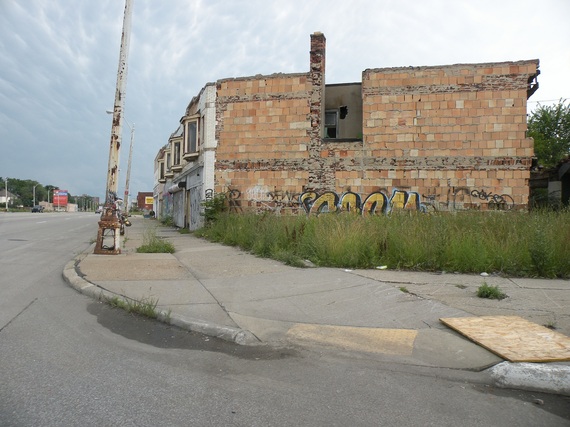
View down a deserted Detroit street.
Isolated populations inhabit ghost neighborhoods of deserted buildings. In some vicinities, all of the structures on entire blocks have been demolished, leaving only empty fields of weeds, grass and debris.
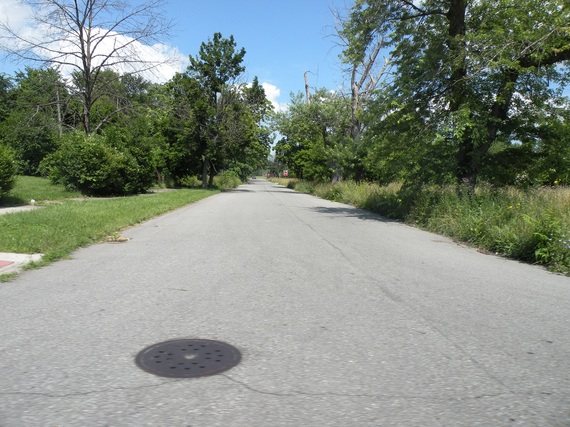
A street surrounded by fields, the former sites of buildings that were demolished.
In other areas, many houses still remain, but nearly all of them are in various states of decomposition, from boarded up to burned out, possibly casualties of "Devil's Night," the night before Halloween, when people burn abandoned houses for fun.
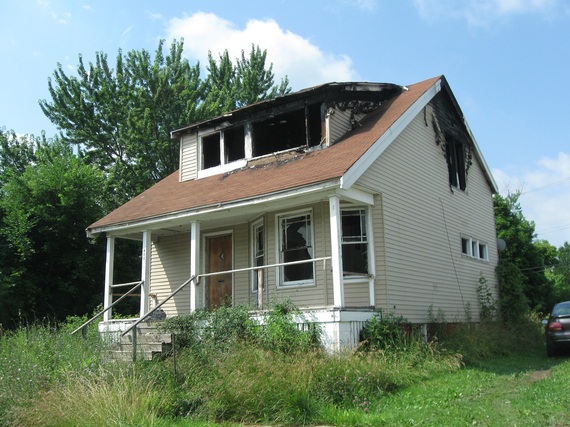
One of the many burned-out houses in Detroit.
Site of a recently razed house.
Venerable, large, many of these crumbling structures would probably have been cherished as historical homes were they not situated on land that has negative value. Driving between several blocks of row houses, one might see only five or six people. Commercial and industrial zones are even sparser. Crime and civic breakdown are so bad that businesses won't move in.
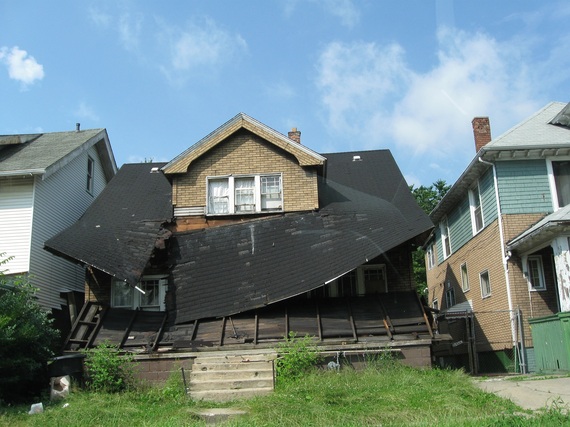
A collapsing house, apparently recently occupied.
Disquiet and amazement at the scene were swirling around in my mind when I was astounded by another phenomenon. Paintings were everywhere. To be on one of these deserted streets was to be surrounded by a singular mélange of sign paintings, graffiti, mosaics and unusual advertising posters and installations. I didn't go to Detroit to see art. I went there to see the city. Little did I know that even though I wouldn't even make it to see the famous murals by Diego Rivera, I would see more paintings in two days driving through Detroit than I could possibly see in the same amount of time at galleries in Los Angeles. It is amazing that public art flourishes in a city known for trying to sell off its art museum. Perhaps it doesn't need one. The broken down brick and mortar of the city itself has become a huge outré art gallery.
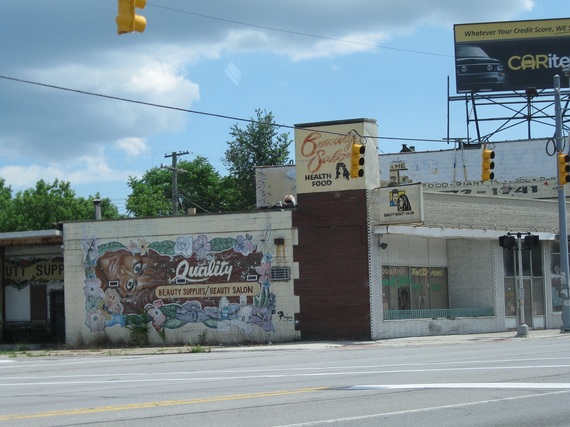
An interesting sign painting on the side of a hair salon. The floral border is done in a graffiti-esque style, as are many other signs in Detroit; many business owners are not totally opposed to graffiti.
Detroit apparently has a long tradition of commercial painting. In contrast to the prefabricated signs that seem to be the norm in most cities, nearly all of the commercial buildings I saw in Detroit were hand-painted with not only text, but also pictures illustrating the services or goods offered inside. Many of these murals were painted in highly original styles, without a trace of predictability or mass-production as one might expect. Sensitively painted images of sundries such as pizzas, fruit, or tires remain on vacant buildings, testaments to a previous occupant. Sometimes, multiple layers of paintings serve as monuments to several generations, as, whether out of respect or neglect, new businesses never removed all traces of predecessors. Now these old paintings serve as foundations for new graffiti, which in many cases, augments and draws attention to them more than it obliterates them.
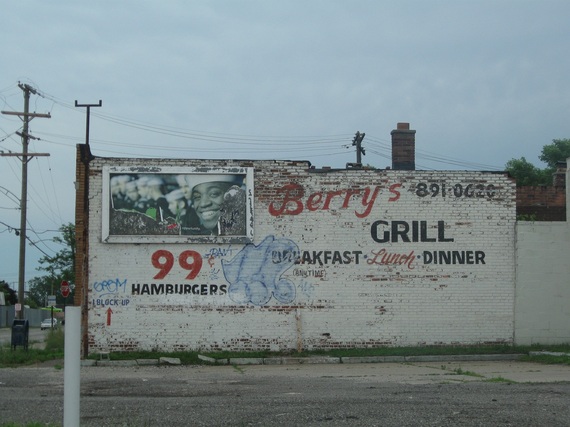
A building collaged with signage and graffiti.
Strangely, though most vacant commercial buildings are covered in profusions of colorful graffiti, hardly any open businesses have been touched by it. Likewise, very little graffiti has been covered over by other tags. Looking at block after block of tagged buildings, it becomes evident that a fairly strict etiquette is in place, followed assiduously by most graffitists.
And why should there not be one? The abundance of unused buildings leaves plenty of room for everyone who wants to leave a mark. There is little reason to cover over others' work or deface businesses trying to stay afloat, except to make a negative commentary on them. This is graffiti artist paradise: Most of the city is a blank canvas.
In fact, metropolitan Detroit has recently become something of a mecca for street artists, as graffitists from around the world have been flying in to take advantage of the abundant opportunities. Some have even moved to Detroit, including "Revok," formerly from Los Angeles.
The city's international fame among graffitists might be partially due to "The Detroit Beautification Project," a joint effort started last year by a team of street artists including Revok, local galleries, and a spray paint company, who have succeeded in securing approval from building owners and city officials to paint murals in Hamtramck, a small city enclosed by Detroit.
Yet in spite of their abundant opportunities, street artists in metro Detroit face a great deal of opposition. A May 2012 post on Detroit's Metro Times blog reported that residents of Hamtramck circulated petitions calling for the removal of some of the murals; but a counter-petition in favor of them garnered over twice as many signatures. The possibility of mural removal was discussed, but ultimately dismissed, at city council meetings.
I saw a number of the Hamtramck murals. Technically admirable and conceptually prepense, they were more sophisticated than typical graffiti. Still, I was more drawn to the total inundation of graffiti and signage in Detroit itself. Detroit's polyglot accumulations of paintings seemed more vital, more representative of the world around them than Hamtramck's individual artworks. In Hamtramck, each mural seems detached, not quite connected to its surroundings. Possibly, this is because they were more planned and labored, less spontaneous. More probably, it is because they are isolated -- each one exists as a solitary unit, with little or no other painting beside it, in contrast to Detroit's unplanned cacophony of work by different artists from different time periods for different purposes. Bold, colorful painting has taken over Detroit, almost in defiance of the city's breakdown.
Some of the pieces are name tags in styles ranging from hastily scrawled to intricately detailed; some are clever epigrams; others are more overt expressions of affection or antipathy towards certain individuals. The tone of these statements ranges from comic to somber; many memorialize the dead. I even saw a few inscriptions urging people to vote for certain candidates for political offices. (I later heard that one of these candidates had painted over some such graffiti himself, fearing that it would do more harm than good to his campaign.)
Cottage industries have developed around creating custom advertisements, evinced by signs to that effect along with Photoshopped examples of their handiwork pasted amongst the graffiti. Not all of the graffiti was text; much of it was images. Enterprising taggers had even covered entire sides of high-rise buildings in abstract splotches of color.
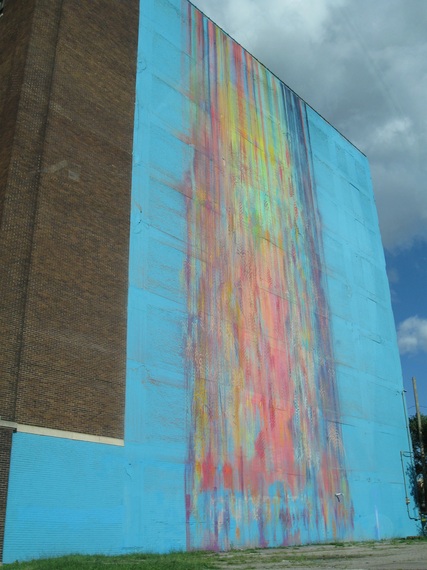
A waterfall of spray paint.
Wandering around the city, I became more and more intrigued by my painted surroundings. I wondered why I'd never paid much attention to graffiti before. Due to its general illegal or undesirable status, it typically exists in the margins of society. In affluent neighborhoods, a graffito seems reactionary, an obtrusive tattoo on genteel surroundings; in other locales, it could serve as a territorial signal or billboard the identity of the artist, or simply convey some idea or image. Either way, conspicuous graffiti is usually covered over unless it is in an out-of-the way or hard to reach location. Instead of existing in the margins, in the wastelands of Detroit, graffiti is to the fore.
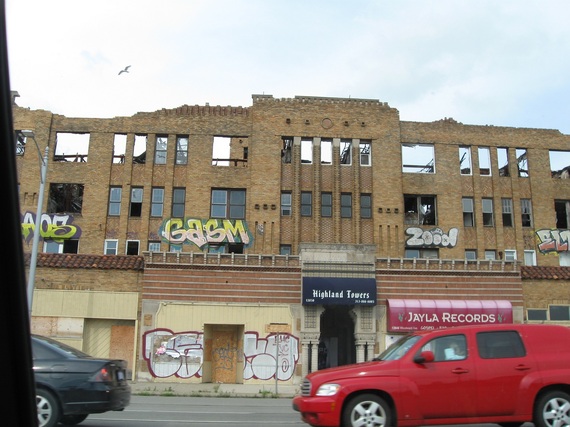
New signage, but the roof on this building is gone.
Empty walls become forums for communication, public diaries. It feels as though the city is literally writing its own history on itself. The experience of traversing one of these areas is poignant and completely engrossing.
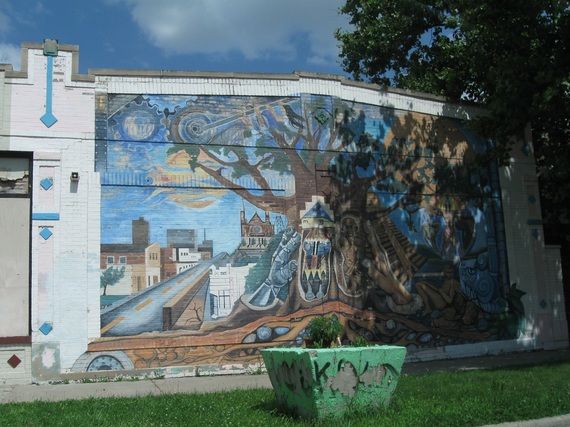
Mural on the side of a building in Mexicantown, a Detroit neighborhood.
The more graffiti I saw, the less I noticed all the detritus. I became so absorbed in looking at the paintings that I almost forgot where I was. It's hard not to become depressed when surrounded by such squalor, but the graffiti, combined with the interesting commercial paintings, provides a more interesting and cheerful center of attention. Few people think illicit graffiti should be legal, for few would want their own property altered or defaced without their permission. Therefore, graffiti is generally considered a "bad," in economic terms; and the more noticeable, the worse. However, in the unique case of Detroit, graffiti, more prominent than ever, seems to swing more toward the status of being a "good." Here the graffiti has value because it provides a stimulating contrast to the lugubrious urban landscape.
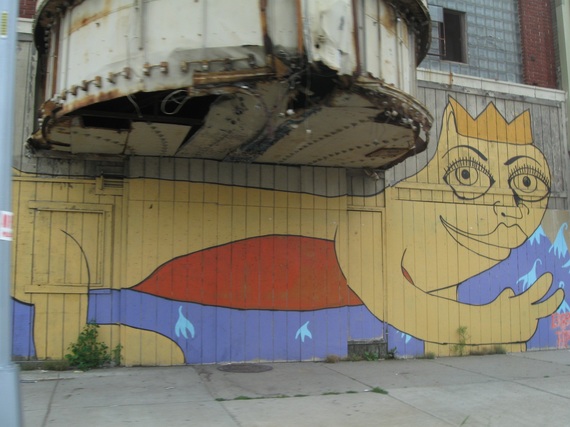
Is this whimsical drawing graffiti or is it an authorized mural?
Not everyone in Detroit feels that way, of course. In fact, some residents are so opposed to graffiti that they have begun acting as de facto anti-graffiti squads, physically assaulting street artists and damaging their cars, knowing that graffitists won't notify the authorities because their actions are illegal as well. Vigilantes attacked more than 12 artists in the month of June, according to a June 28 article in the Motor City Muckraker webzine. Local disgruntlement is certainly understandable, given the fact that outsiders and even foreigners are coming in to Detroit to leave their mark. Considering graffiti's stigma and its territorial connotations, it's not unreasonable for locals to feel that these graffitists are marking territory that isn't theirs in an effort to take over. It also is hard to dispute that the graffitists, especially the outsiders, are taking advantage of a bad situation. They don't have to live in it. It's easy for them to sail through the murky backwaters in relative peace, unanchored by poverty or deep ties to the area; just as it was easy for me to pass through the city, enjoy its art, and now comment on it.
The graffiti might have value, but to whom? A Detroit art gallery achieved some local notoriety when they removed a mural, wall and all, by the famous professional artist Banksy, from a building without permission from the building owner. In Hamtramck, locals whitewashed an unapproved billboard by professional collective "TrustoCorp", but the collective had it removed and secured, presumably for reuse and eventual sale. According to the May 2012 Metro Times blog post, if it were restored, the billboard would fetch between $10,000 and $20,000.
I'd never had much interest in the genre of professional "street art," as seen in galleries, because its paradoxicality seems to overstretch its credibility. There are many exceptions, but often, its concepts seemed to me to be specious, its motifs derivative, and its relational aesthetics too facilely predicated on spurious disobedience to authority. Perhaps I felt that if this sort of urbane graffiti represented the pinnacle of street art quality, I wasn't interested; or maybe I just hadn't looked at enough graffiti to understand the complexity of its dynamics. At any rate, seeing the art in Detroit opened my mind toward a greater appreciation of graffiti of all kinds.
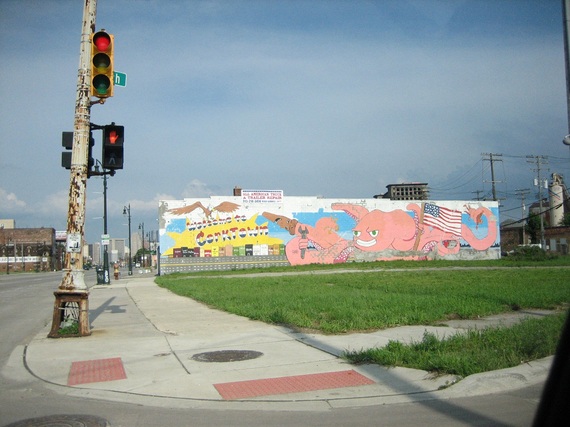
A mural in Corktown, Detroit's oldest neighborhood. Notice the rusted traffic light in the foreground.
The Michigan Department of Transportation (MDOT) website bears a brief essay titled, "Graffiti: Artistic Expression or Vandalism?" It is amazing that people are so shallow as to reduce such a complex and multifaceted issue to a simplistic either-or. To ask such a question is to equivocate a political issue with an artistic one. Art and vandalism are not mutually exclusive. If an artist paints on a canvas that isn't his, is his painting therefore not art? Unauthorized graffiti can be both art and vandalism. Artists who decide to go outside boundaries, whether legal, social or traditional, do so knowing that they might face consequences. For them, the risk is worthwhile. Even some proponents of the genre make a distinction between graffiti and "street art": in their definition, graffiti is illegal, whereas street art is legal. Ironic, considering that the definition of the word "graffiti" doesn't predicate illegality, but street art is often shown inside galleries.
The article on the MDOT website urges anyone who witnesses a graffitist at work on bridges or overpasses to alert authorities. The Michigan government doesn't want the city's problems spilling over onto state-owned highways, so it spent more than $500,000 in 2012 on graffiti removal in the Detroit metro area. Personally, I found the graffiti more interesting and appropriate to the area than the manufactured charm of the ornamental walls.
When people pit graffiti's artistic and legal characteristics against one another, what they seem to want to discuss is: is graffiti good or bad? Could its benefits possibly outweigh its detriments? Does its transgressive nature nullify its artistic value, or vice versa?
Clearly, the issue is more symbolic than functional. In the case of Detroit, the debate becomes purely theoretical, since the authorities don't do much about it anyway, nor should they. Funds are too short. The money is needed elsewhere for major services, and the city recently declared bankruptcy. Traditionally, graffiti is illegal because it undermines property owners' control over their belongings. The owners of most of Detroit's prolifically decorated buildings have long since relinquished control over them. Whether or not the graffiti looks worse than a disintegrated building is an aesthetic issue, not a true problem. Surely the graffiti is not bringing down the property values in most of these areas of Detroit, for the property value is, in many cases, already negative. The graffiti simply isn't doing any harm. Crimes much worse than illegal graffiti are being committed every day throughout the Detroit metro area; some areas are so dangerous that the police won't even enter them. In an effort to shoulder some of the responsibilities abdicated by police, residents of some areas post signs to telephone poles warning visitors that roaming thieves may steal gold jewelry right off their bodies.
The altered social and political dynamics in Detroit have transformed the graffiti dynamics. Rather than an intrusion on a civilized veneer, in Detroit, graffiti is there at every turn, on practically every street corner, reminding passers-by that no one in this city is really in control. Detroit's no-man's-land is, paradoxically, a free-for-all. Instead of sabotaging the look and principles that the city purports to stand for, these artists are working with them. They are finding freedom of expression amid political and social upheaval, creative oases in a rotten world. These artists aren't subverting the property owners, per se, but rather exploiting the oppressive environment that is their canvas, the decayed political and social structures it represents. Graffiti is a symptom of Detroit's problems, hardly a part of them. The more graffiti there is, the more political and social breakdown is symbolized. This is precisely why, in a broken, bankrupt city rampant with theft, violent crime and jailed politicians, graffiti is still such a hotly contested issue. The artists' willful acts lay bare the ineffectuality of the city's governmental infrastructure, and many do not want to admit it. They are so invested in the city that the gritty magnetism of its painted surfaces fails to appeal to them.
One empathizes with those who live in and love Detroit. It is truly regrettable that what was once one of our country's greatest, most vibrant cities has become so desolate and distressed. In this urban desert, the murals and graffiti serve as reminders that the place is still inhabited by people, ones who have feelings, ambitions and creativity. The pictures and words exist to be seen and read, acknowledging viewers passing by as much as they proclaim their creators.
The tattered, painted fabrics of Detroit burned themselves into my brain. They continue to haunt me, prompting me to think of issues that I hadn't before considered, such as the ones I've just discussed. I no longer look at cities or graffiti in the same way. Despite its problems, Detroit possesses a rare and ghastly pulchritude, well worth seeing by anyone interested in graffiti, urban decay, or Americana.
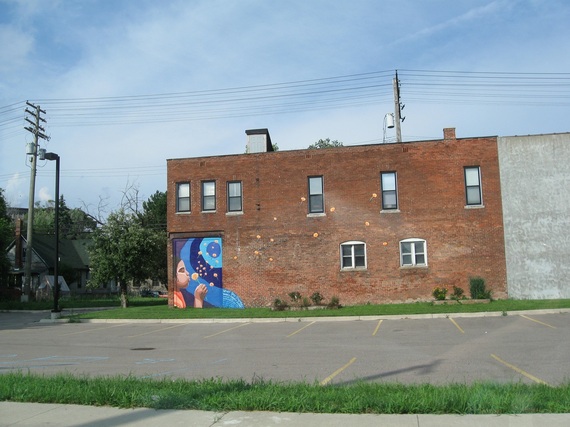
"Never Stop Dreaming/Nunca Dejes de Sonar," a mural by Jen Boyak.